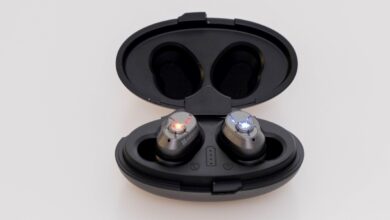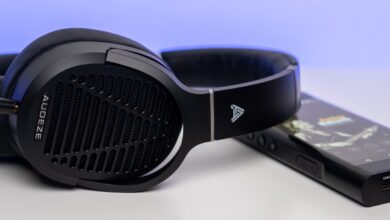Erzetich Charybdis Review – A New Dimension In Sound

My Video Review:
After trying some of the best dynamic, planar-magnetic, and electrostatic headphones, you would think that new cans seen on the horizon wouldn’t impress a headphone junkie like me. The truth is, new technology always moves forward and since we already have top-tier headphones on the market, manufacturers are pushing the envelope much harder today, challenging themselves in creating better & innovative products.
When I started this hobby, there were uber high-end loudspeakers all around, but not as many great-sounding headphones. Top-of-the-line Sennheiser, Beyerdynamic, AKG, and Grado headphones weren’t exactly end-game material and while some of them were doing an excellent job, I still don’t find them highly resolving or technical sounding enough. Today, we don’t have that problem anymore as boutique headphone makers slowly caught up with legendary-sounding loudspeakers. We are living in the golden era of headphone listening and if your pockets are deep enough, you can have it all in the comfort of your home. Unfortunately, the prices of end-game headphones skyrocketed in the last decade and I fear that the audiophile press can’t stop that nasty movement anymore, it’s way too late for that. People made fun when Sennheiser revealed their $1300 HD800 in 2009, people made funnier jokes when Grado unwrapped their $1600 PS1000 set shortly after. Having a $4000 Audeze LCD-4 in 2016 was already a norm, but when Abyss Headphones revealed their very first set of cans at $5500 which sold like hotcakes, it was a sign that the industry’s limits are expanding at an alarming rate. It still bothers me that we need to pay astronomical prices for a great-sounding set of cans and if paying $6000 for a set is already standard procedure, I’m wondering what the norm would be in five or ten years from now.
Let’s zoom out for a bit and talk about a different headphone manufacturer that just outdid itself and outplayed everyone else. You might think that I’m overhyping things a little…but that’s never my intent and it’s not what an independent publication does. I don’t care for greedy manufacturers or online marketplaces, I care only about my tribe, about you. Blaž Erzetič is a guy I have tremendous respect for as a human being and as a boutique headphone maker. I have recently cast a shadow on their older Mania V1 headphone in a direct comparison with a Meze 109 PRO and can you guess Blaž’s next step? He invites me to make a world-first review for his newest flagship planar headphones. How can I say no to such an honor? Today I’ll write a story about their newest Charybdis that doesn’t look like an updated Phobos V.2021. No, my friends, these are built from the ground up and in many ways, these are among the best-sounding planar-magnetic headphones I have tried so far. They won’t cost you an arm and a leg, coming at a reasonable €3000 price and if you hurry up, you can snatch a bad boy like this at a 15% discount by using our promo code, which will be revealed soon.
Charybdis aren’t ordinary planar headphones, they have one key element that makes them unique, and before I’ll tell you a great deal about them, let’s take a look inside their package.

Unboxing Experience
When you are dealing with a triple-boxed affair in which a metallic suitcase works as the last line of defense against crazy delivery guys like Ace Ventura, you know these folks are serious about their craft. Charybdis is no longer coming in a cardboard case as it was the case with their Phobos, Mania, and Thalia headphones, getting a much nicer case that reflects their ranking. The case is considerably bigger than that of the Meze Elite and Audeze LCD-5 and in many ways, it reminds me of a nuclear briefcase that’s usually carried by men in black around world leaders. It’s massive only because it carries the world’s biggest headphones wrapped with a substantial amount of foam for better protection. It features a locking hinge and you can lock it with the included keys just in case you’ll be traveling. Besides the headphones themselves, you are getting two keys, a certificate of authenticity, an owner’s manual, a velour pouch, a high-quality detachable headphone cable terminated with a 4-pin XLR jack, a 4-pin XLR to 6.35mm headphone adapter, and a pair of velour earpads that will give you a different sound flavor.

Build Quality & Looks
Erzetich Phobos V.2021 was a mammoth of a headphone, the biggest I ever held in my hands, having the largest earcups out there. It was the scariest-looking headphone from my collection and I always liked that about them. Now imagine that from those massive drivers, Blaž retrofitted his newest creation with the biggest headphone drivers in existence (105 mm by 115 mm) forcing him to move the headphone connectors outside their earcups. As Blaž explains in the Charybdis introductory video, he tried different approaches and one of them had the headphone connectors attached separately to the machined aluminum cups, but the prototypes weren’t looking great and the only thing remained to do was to move the headphone connectors outside their cups. As you can guess their cups are massive, slightly bigger than those of Phobos V.2021, and considerably bigger than any other headphones on the market. I always thought that Audeze’s LCD line was mean and aggressive looking, but put a Phobos or better yet a Charybdis near them and LCD-4 will look like an obedient kitty cat.
Blaž is still crafting the Phobos, Mania, and Thalia headphones out of linden wood, having a metallic cover over the wood that absorbs nasty vibrations. This time around, their cups were carved entirely from aluminum blocks on CNC machines, add a wider strap that will better redistribute the weight around the head and a fiberglass headband and we are getting a rock-solid headphone that still has that manly Erzetich look. While these are their heaviest headphones on the market, they are honestly fairly comfortable to wear due to the much thicker and plushier earpads that were filled with soft memory foam. I have plenty of headphones around the house, but I do feel Charybdis have the plushiest and softest earpads that seriously improved their comfort levels. There’s no clamping force around my ears and mind you, my melon is on par with that of the Megamind. Instead of rubber straps, we’ve got a wider and softer headband, which drastically widened the weight distribution. I find them comfier than any Audeze headphones, approaching the comfort levels of Meze Elite and Hifiman HE1000SE.
There is one thing I like about Erzetich-made headphones, having all their cans symmetrical looking without putting L and R markings on their cups. You will be deciding which will be your left and right earcups and I started appreciating such a design immediately after getting the Phobos OG, which is so easy to use in video B-rolls. I have a slight OCD in everything I do, everything needs to read and to look pristine, otherwise, I won’t publish anything and I’m getting that perfect vibe when I’m looking at Charybdis, so kudos to Blaž for that.

Tech Inside the Erzetich Charybdis
Instead of shrinking the size of their planar-magnetic driver (for better driver control & transient response) as HiFiMan and Audeze did with their Susvara and LCD-5 models, Blaž went in the opposite direction mounting the biggest headphone drivers out there. At 105 by 115 mm, these will feel like having big woofers glued to your ears and I’m sure these will have an impact when music will start playing. We don’t have additional information about these drivers, except that these are extremely lightweight & rigid.
We’re talking about 100% open-back planar headphones and you can see massive openings on their cups that will move unwanted sound waves (happening behind their drivers) outside their cups. The diaphragms are firmly supported by the CNC-milled aluminum cups, so you can forget about vibrations or distortions building up at higher volumes, as that isn’t going to happen. Their massive 740-gram weight comes mostly from their powerful engine consisting of a double-sided magnet structure working in a push-pull configuration.
Some of the nicest things about them which are their low impedance of 43 Ohms and their high sensitivity. Although sensitivity isn’t mentioned anywhere, there is a 0.5dB difference versus a Meze Elite in favor of Charybdis (more sensitive) resulting in an approximate sensitivity of ~105 dB per a single mW of power, but more about that in a dedicated chapter.

Test Equipment
A flagship planar-magnetic headphone will need a flagship headphone setup to shine at its best and that’s why I went overboard with electronics. I used a Rockna Wavedream NET ($10.000) working as a music server (4TB of SSD storage) and as a Roon server working in conjunction with Qobuz and Tidal. A Rockna Wavedream Signature XLR DAC ($20.000) followed via i2S connections and then a marvelous sounding Trafomatic Audio Primavera ($15.000) which will squeeze the last drop of performance from the Charybdis.
Sound Performance

I. Preliminary Sound Impressions
Without any burn-in, I put them on my head and there was a long moment of silence, followed by a loud bang as my jaw hit the floor. Ten minutes later and I was already writing an email to Blaž congratulating him for such an achievement, as honestly these are up there with the very best headphones on the market, and let me explain to you why.
As the transient response guy, I love when headphones are sounding incredibly snappy & alive while being in control the whole bloody time. It’s easier said than done, as there are only a few headphones that can be fast, impactful, and controlled at the same time. Audeze LCD-4 are hard slamming down low but they don’t have a need for speed, nor a super tight control. LCD-5 have the speed, but they don’t have the slam, especially in the low-end. Hifiman’s Susvara can have it all, but only on uber-high-end & expensive amplifiers. Kennerton Wodan weren’t that fast, but their Rognir were considerably faster, Erzetich’s Phobos were incredible in the mid-bass, but not so much in the sub-bass, lacking definition and oomph in the lowest octaves. Abyss AB-1266 were both speedy and impactful, but you needed to sell a kidney for a pair & a matching amplifier. The good part about the Charybdis is that you don’t need an end-game amplifier to awake nicer dynamics, an ultra-fast speed & a thunderous impact. These sounded wonderful even out of a Topping A90 Discrete and SMSL HO200 and I didn’t even need to engage high-gain to have my earlobes flapping in the air.
Above all and everything, Charybdis are fun and engaging, they will immediately put a Glasgow smile on your face and they will make you an air drummer in no time. In my opinion, these are incredibly fast & great slamming in the bass, having incredible control over their drivers. It depends on the amplifier that drives them, but I don’t find them demanding like most planar are, these are certainly not hungry sharks as Susvara or AB-1266 are.
Surprise no.2 was getting a highly resolving & transparent sound. I find them so resolving that after moving from a HiFiMan’s Susvara to Charybdis…I don’t feel the urge to put them down on my table. After a few days of fierce battles and comparisons, they became the second-highest-resolving headphones from my collection and that should tell you a thing or two about their detail retrieval and transparency.
The biggest shock I had was getting a very Sennheiser HD800-like soundstage and depth. There is just a single planar-magnetic headphone that can challenge them in terms of soundstage and depth and that’s the Abyss AB-1266, but I still feel that Charybdis are even wider & taller sounding.
These are some big words and I understand their weight and gravity, but that’s all true. These will be mimicking the scale of the Sennheiser HD800 as tunes are always big, airy, and holographic. I don’t remember opening the door of my office as often with a pair of headphones, as there’s always a feeling that a few sounds are coming from outside my crib. I’m always turning my head when live music or well-mastered jazz starts playing. I finally found my movie-watchin’ & games playin’ planar headphones that could replace my beloved HD800S.
If you follow my words, then you already understand that I’m not describing a common-sounding headphone, but a unique one that has a few traits usually found at a much higher price point. Last but not least, I find them balanced and extended in the frequency response, there is a good deal of sub-bass, mid-bass, midrange, and treble. Everything sounds clean, natural, and highly entertaining. Everything breathes, nicely decompressing my music into a million pieces. These are flagship material that could be compared with some of the best-sounding cans out there.

II. Power Requirements & Amp Pairings
While I love the HiFiMan Susvara for so many things, I strongly dislike their sensitivity which made me spend a good fortune on high-end headphone amplifiers, but also on integrated and power amplifiers that were supposed to drive passive loudspeakers. At one point I was driving the Susvara with two Benchmark AHB2 power amplifiers used in mono mode, that were providing about 480 Watts into 6 Ohms that awoke much nicer dynamics. Trying an Enleum AMP-23R ($6500) almost made me sell the AHB2 duo, as it was impactful, but considerably livelier and organic sounding. About a year ago Susvara made me purchase of the infamous 30-kilo Trafomatic Primavera ($15.000) which further improved their performance and pushed them to higher highs than ever before. I never wanted to swap my amps so often and drain my bank accounts dry, just imagine the impact on your audio chain and your wallet a lower sensitivity can do.
Luckily, Charybdis aren’t like that and if you ever tried their Phobos, Meze Empyrean & Elite, Kennerton Wodan & Rognir, then Charybdis are on the same level. Did they sound better from the Primavera versus the Topping A90D? Of course, they did, but the difference wasn’t as massive as was the case with the Susvara and AB-1266. Charybdis are getting more impactful, fuller-bodied, and bigger sounding, but every other trait remained unchanged.
Even portable devices sounded great with them and just before bedtime, I would always use a Shanling H7 or a FiiO Q7 linked to my phone, checking if new albums hit streaming platforms. I had no issues driving them with portable digital audio players like HiBy R6 MKIII, Shanling M6 Ultra, or FiiO M11 Plus ESS. They all worked like a charm, although I needed to engage their high gain and use their balanced outputs for the best results. Charybdis seems to like a stronger current delivery as when I was climbing the ladder from small USB dongles, Bluetooth thingies, portable DAC/Amps combos, portable DAPs, and to desktop stacks, there was always an improvement, be it in terms of dynamics & control or the resolution department.
A headphone of this caliber will demand a desktop setup consisting of separate devices, but don’t worry if you still use an all-in-one combo or an above-average portable DAP, as these will do just fine with the Charybdis. On the Topping A90D, I never went higher than 12 o’clock on its mid-gain position and on the Trafomatic Primavera, I’m barely touching its 10 o’clock position. Sennheiser HD800S needs more power than that (more voltage more exactly), and Meze Elite are by a hair less efficient, together with Sendy Peacock and Kennerton Rognir. These are among the easiest-to-drive planar headphones I have come across and that makes me feel great, as I can carry them on long trips, use them in hotel rooms or on deserted beaches looking at the sunset.
I won’t worry about the power delivery, but I would seriously question the quality of that power as these can become highly resolving as long as your amplifier has the same traits.

III. Transient Response
Just a few days ago a good friend of mine lend me his Rockna Wavedream NET music sever / Roon core / Wired streamer and since he is a headphone listener, I put a beer in his hands and let him try the Charybdis. I took a photo with my phone in the first 10 seconds of use and his face said it all, words were unnecessary. When a person laughs instead of smiling and covering his face with bare hands, clearly something happens on the subconscious level. Something clicked in an instant and what was supposed to be a quick gear swap, transformed into a long listening session. Five beers and a few hours later, the man asked if he can borrow the headphones after I finish with them.
Stories like this maybe won’t reflect your first experience with them, as we still have different ear shapes, listening habits, and music preferences, but my impressions mirrored those of my friend. Put them on a decent-sounding amplifier, ideally one with fully discrete electronics working in a deeper Class-A operation, and watch eardrums being transformed into punching bags. I always loved their Phobos for their out-of-head experience, I enjoyed their elevated mid-bass delivery, but I could never get over their uninspiring low-end that had little to no authority. Charybdis are by orders of magnitude better in all regards, but especially in the low-end. At 20 Hz their newest headphones are by 10 dB stronger compared to Phobos V.2021, getting a negligible ~2dB sub-bass roll-off from linearity. More importantly, these are delivering a visceral and highly energetic type of bass, a hit-and-run type that slaps you and walks away as if nothing happened.
Rockna Wavedream Signature XLR is so far the snappiest and hardest slamming DAC I had the pleasure of listening to in the comfort of my home, outperforming an equally impressive Chord Electronics Dave that I’m still using in a stereo setup. I’m sure that Wavedream Signature added plenty of life to my headphone battle station, but I cannot deny the snappy, fast, and thumpy-sounding nature of the Charybdis. Forget everything you know young padawan, a funny voice was shushing into my ears, as Charybdis have nothing in common with the Phobos or Mania for that matter. Mania are quite slow for my taste, these are always mellow & unoffensive sounding. Phobos V.2021 are their arch nemesis, always sounding lightning-quick, at the cost of becoming aggressive, especially on treble-intensive tracks. Charybdis on the other hand are speedy and impactful, without becoming aggressive sounding. There’s no elevation in the mid-bass, and there aren’t spikes in the upper-treble, getting a broader frequency response that’s more natural, without going into the bright or warm-sounding camp.
SaxNBass by MarkusPhilippe (Qobuz / Tidal) sounds exactly as you would envision it, accompanying a sax with a cello (double-bass) in a bigger room so the sounds won’t mess up and intertwine. While the sax felt alive and deep sounding, the star of the show was the double-bass player. It had a long trail and its vibration felt so alive, you can hear his hands plucking the strings with a higher force than usual, getting a powerful rumble down low. This album isn’t always powerful, layered, and well spread around my head, and usually, it isn’t stopping me from my work. I left my keyboard, I reclined my chair and only after the third track, I started putting down some words. The naturalness, warmth, and see-through transparency made me stop and think for a few minutes.
Drum Solo by Gojira (Qobuz / Tidal) was a track that I listened to with my hand touching the volume pot, as dynamics went through the roof. Charybdis were combining the immaculate speed and precision of a technical drummer with the slams of big drums and snares that I’m always prowling for. The kicks were instantaneous, decaying just at the right time. These were stopping on a dime and in my experience, not a lot of headphones can pull that off.

IV. Soundstage & Depth
Some people think it’s silly talking about the soundstage on headphones. It’s as silly as talking about the soundstage in a stereo setup. I couldn’t get over the claustrophobic sound of Audeze’s newest flagship and the lack of low-end rumble made me even sadder. I’m a huge fan of the LCD-4 due to their creamy and overly-dense sound. A few years ago, LCD-4 were unbeatable at stereo image and depth when compared to competitor planar headphones and I don’t understand why, but LCD-5 no longer has that legendary depth, nor the out-of-head sound that was hovering a meter away from my body. I didn’t enjoy the newest LCD-5 as much, dynamics weren’t up there with the very best and their closed-in sound brought listening fatigue, shortening my listening sessions.
Charybdis on the other hand, are always pushing the sounds outside my head, more so than the Meze Elite, Audeze LCD-4 & 5, Hifiman HE1000SE & Susvara and I find them considerably airier than any other planar headphone. From my headphone collection, the only ones that can challenge them are Sennheiser’s HD800S. What was a blessing for HD800S on their release date was also a curse, as although HD800S were mimicking the sound of a near-field stereo setup, that long sound travel removed some energy, getting a softer overall performance. HD800S can’t rumble with the big boys in the dynamics department, as their energy falls short even on high-end amplifiers. Charybdis aren’t like that, playing all around my head without dropping energy levels. There’s no softness with the Charybdis, there aren’t hazy leading edges, and everything’s crystal clear, yet powerful and highly energetic.
The big sound oozes from colossal drivers, but that impressive driver control can only be obtained from a powerful magnet system that would bring the thunder and stop the lightning. The funny thing is that I didn’t even need to listen to perfectly mastered recordings to feel the air passing by. Modern tunes weren’t mandatory as my eardrums were train wrecked even on soft underground drum’n’bass. For the biggest drivers of the headphone kingdom, you will need bigger magnets to control that force, especially at higher volumes, add weighty CNC-milled cups that are absorbing a lot of the energy and we’re getting little to no distortion building up across the frequency response (as my measurements will later prove). I can go on and on about their massive sound that stretches wide open and I would still arrive at the same conclusion that Charybdis are so far the no.1 planar headphones in terms of scale, imaging, and depth.
Almost five decades ago Bohemian Rhapsody by Queen eclipsed The Prophet’s Song (Qobuz / Tidal) I never understood that as for me, the latter was so much more interesting. Years have passed but it still feels like listening to a binaural recording via headphones and as a Dolby Atmos experience via loudspeakers. It’s a song about the world falling apart, about people raging against each other and not knowing who to follow. Sonically it’s a track split in two: between and after the big schism that happens at the 3-minute and 23-second mark when voices start traveling from left to right and vice versa, creating a complex interplay inside your brain. Instead of being confusing or tiresome, Charybdis placed everything in massive bubbles of sound, pushing huge void spaces in between them. The 3D show goes on for 3 minutes, encoding a sad story into melody, wrapped in sonic trickery. Its spooky atmosphere always pushes my imagination further with multi-part arrangements that lead to a cinematic feel. In my humble opinion, The Prophet’s Song is the quintessential Queen track for headphone junkies around the world.

V. Detail Retrieval
One of the reasons a Chord Electronics Dave and a Rockna Wavedream Signature XLR are staying on my table is that I didn’t experience higher resolving sources yet. These two are bringing forward the last bits of information. All the small things that are hiding behind your tracks on mid-end to upper-class DACs are coming forward in such an easy manner, that I no longer need to close my eyes and stress myself to hear them. Detail retrieval matters, it’s the most important skill of a DAC. It matters in downstream and upstream equipment, you want to have it in your speakers and headphones as at the end of the day, these will be providing the smallest intricacies that are making our tunes so much more interesting. I’m exploring music for half of my life and I can’t thank enough my grandfather for that. Yet, it’s always so pleasing hearing more of your music, be it good or bad. Want it or not, mastering errors and imperfections are eternally glued to our tunes. I can’t listen to classical music without hearing people inhaling and exhaling air from their lungs, it adds a lot to the feeling of being there. I need to hear the piano player pressing the pedals under his feet and cello players plucking the strings or slapping their bodies for an added thump, it adds to the experience. All these minor things are extremely important, it’s what differentiates a common setup from a HiFi one. I started slow and I want you to understand that Charybdis are sitting in second place when it comes to resolution and transparency, eclipsed only by the e-stat like HiFiMan Susvara, which still reigns supreme and it will (probably) remain on an iron throne for a while. I’m glad that boutique headphone makers are challenging themselves in making cleaner and higher-resolving cans. I was gobsmacked when I tried the Meze Elite for the first time, as their Empyreans weren’t highly resolving, not fast, or tightly controlled. Elite made big jumps towards the truth and so did Blaž with his Charybdis. Phobos V.2021 were already clean and highly resolving sounding to me, but Charybdis are more so and I no longer feel a massive gap in between them and the Susvara. There’s an approximate 5-10% drop in terms of resolution versus Susvara, putting them at least on the same level with the HE1000SE, slightly above the Meze Elite, Audeze LCD-5, and much higher compared to Audeze LCD-4 and Sendy Audio Peacock.
There are no longer painful peaks in the upper treble, so you won’t bite your tongue on treble-intensive music and you won’t wonder where the sub-bass went when modern tunes will be playing. There are indeed a few small gaps in the treble (as all headphones do), but everything feels right, defined, and well-preserved. From the sub-bass up until the top octave is reached, you are getting a full picture of your music, without things placed on the second row. Considering that Erzetich Audio is (almost) a one-man show (feels like looking in the mirror), I can only congratulate Blaž for such an excellent technical performance. Chapeau Bas, mon ami!

Frequency Response
VI. Bass
The absolute Biggest (with a capital B) drawback of all Erzetich headphones was her majesty, the sub-bass. From 50 Hz downwards a gradual decline happens in the sub-bass, removing about ~12 dB of energy from the 20 Hz region. It wasn’t a big deal for Mania at €1200, but it was a much bigger deal on the €2000 Phobos that was competing in the big league. That was the biggest issue of the Phobos, having an impressive pound in the mid-bass and a much softer one in the sub-bass that couldn’t be taken care of. I didn’t throw the white towel and I never abandoned the Phobos V.2021, I tried a good deal of leather earpads with them, and the ones from Kennerton Rognir and Audeze LCD-4 worked the best, slightly elevating the sub-bass by up to ~3 dB. Blaž knew about this and he started experimenting with different earpads that had different padding materials. Charybdis has brand-new drivers built from the ground up, but he still needed better pads and I think he achieved the best of both worlds. From a 12dB drop on the Phobos, Charybdis has a very gentle roll-off of ~3 dB in the sub-bass, which is a massive improvement. The biggest issue has been solved and I can finally head-bang with a stupid smile on my face. These are providing everything a bass head will ever desire. There is a good extension, depth, cleanness, speed, and fast decays when needed. This is a highly resolving type of bass, similar to that of upper-class Hifiman headphones, delivering layers and sub-layer of bass coming in waves. We are getting tight control over the bass which won’t spill over the midrange region and won’t vibrate for a micro-second longer than it needs to. As I mentioned before, these are stopping on a dime and very few headphones are capable of doing this.

VII. Midrange
A flagship comparison graph will follow shortly, but even without looking at that, it was clear to me that Erzetich planted a bit more life into these. Their Phobos was great in the midrange as most planars do and although at times they had a weird pitch in the upper midrange, Charybdis no longer has that issue. These are doing midrange just fine and although these aren’t as creamy and sweet as Audeze’s LCD-4 and Meze’s Elite, these are going in the same direction. According to my graphs, Charybdis has an outstanding midrange performance, closely followed by the LCD-5. Subjectively speaking, I find them more or less the same as LCD-5 and a little below the Elite when it comes to presence and musicality. I’m a guy that listens to everything, from one-century records to underground stuff that you’ll find on SoundCloud but not on streaming platforms such as Qobuz or Tidal. Midrange is where the soul of the music dwells and if you do it right, then half of your job is already done. Provide a less impressive midrange and you’ll never make them real and believable sounding as most of the sounds happening in our daily lives happens in the midrange. If you ever tried their Phobos, then there is more fullness to the sound, it feels heavier and denser, there’s more energy oozing from vocal cords and more emotions are pouring from string-based instruments. Thanks to a much wider stereo image, things are no longer fighting for the prime time, everything shines properly, getting a rich, warm, and full-bodied sound. You needed to use a warmer setup with the Phobos and a much faster-sounding one with the Mania, but you no longer need to readjust your setup for maximum performance with the Charybdis. If your setup can provide, Charybdis will rise from ocean depths and show what it’s capable of.

VIII. Treble
Erzetich’s previous flagship headphones were strong in the treble department, maybe too strong at times, as past a certain point, Phobos were becoming hot and aggressive sounding. Past the top octave, only Meze Elite and Phobos had a stronger presence in the treble that added more bite. You could tame that with a mild EQ or with a certain amplifier type, but the workarounds sometimes would hurt other parts of the frequency response. Charybdis no longer has that issue, as the whole top octave dropped by about ~6 dB, delivering a natural treble while preserving its pitch and cleanness. There is a faint rise in the most sensitive part of our hearing (around ~7 kHz) which makes it stand out, but not as much as it happens on the HiFiMan HE1000SE. They did a fantastic job in here, as I could listen even to mean rock & metal tunes filled with intensive trebles without tiring me down. Bells and cymbal crashes were crisp and metallic, but without having a fake ringing attached. Since these are fast-sounding, double drums didn’t pose a problem even with the fastest and most demanding tracks. On my setup, listening fatigue never occurred even after a 3-hour listening marathon, but that could have been a slight issue on ultra-linear / colorless-sounding setups. Overall, I think Charybdis have a pristine treble response as things are never getting out of control and their frequency response is close to perfect.

IX. Detailed Measurements
After offering my objective opinions, let’s check how things are looking under a microscope. I used a Singxer SU-6 that galvanically isolated the USB ports of my PC, followed by a Chord DAVE DAC that was doing all the heavy lifting. The measurement rig used was a MiniDSP E.A.R.S. system calibrated with HPN (Original Headphone Compensation) files. Please note that E.A.R.S. is not following any IEC standards, meaning that my readings can’t be used as reference measurements or anything like that. I’m doing them for fun, getting a general idea about their sound signature & performance.
I have measured them several times now, as finding the perfect spot on the test jig wasn’t that easy. No side pressure was applied to the earcups, they stood still in their natural position and I measured them a few times before both channels were matched.
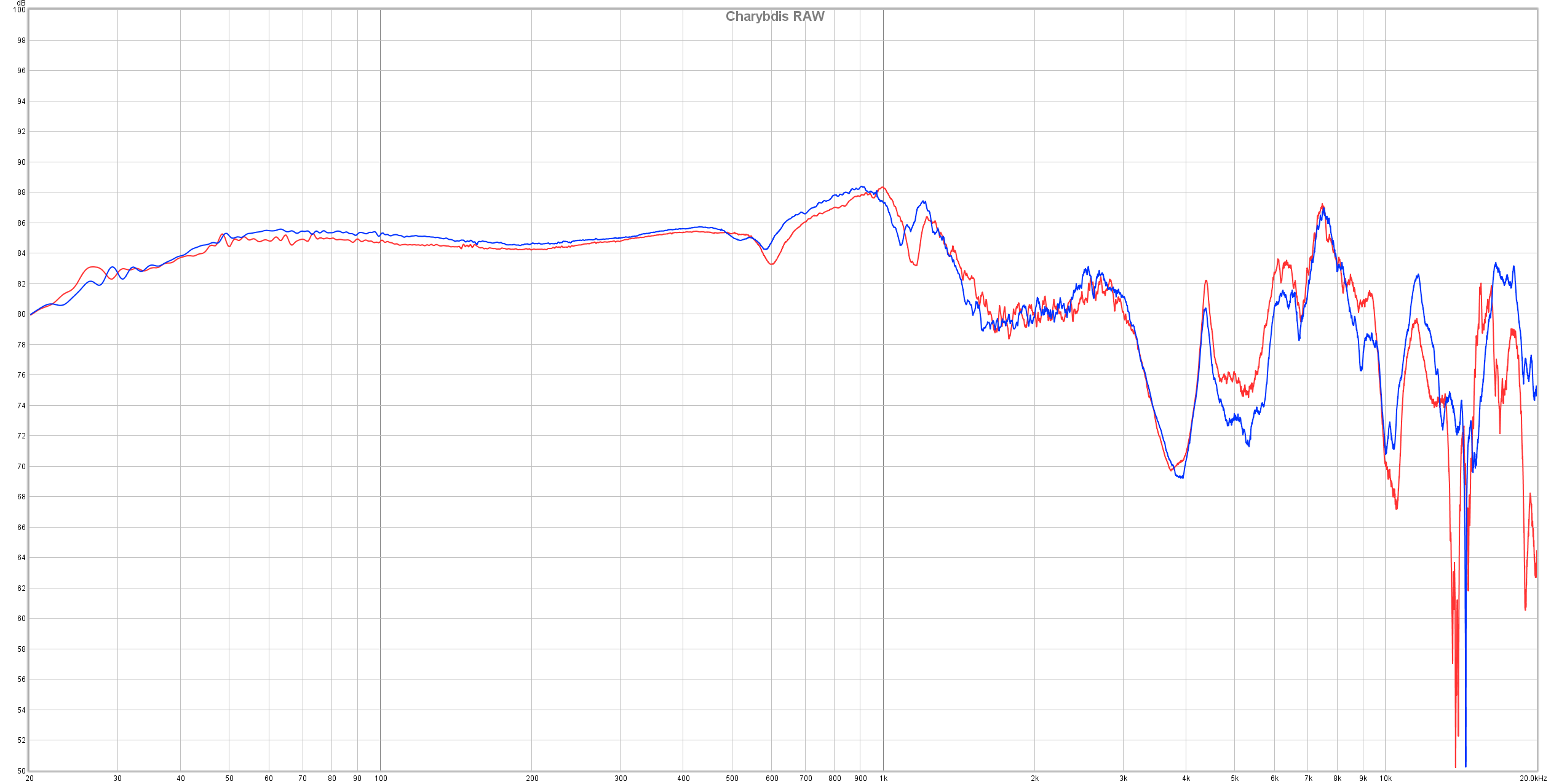
Take a look at their RAW measurements without any smoothing applied. Driver matching looks good, although it’s not perfect. There are plenty of deviations in the treble, but those are not troublesome. This reading was zoomed in a lot, so you could better see the frequency response.
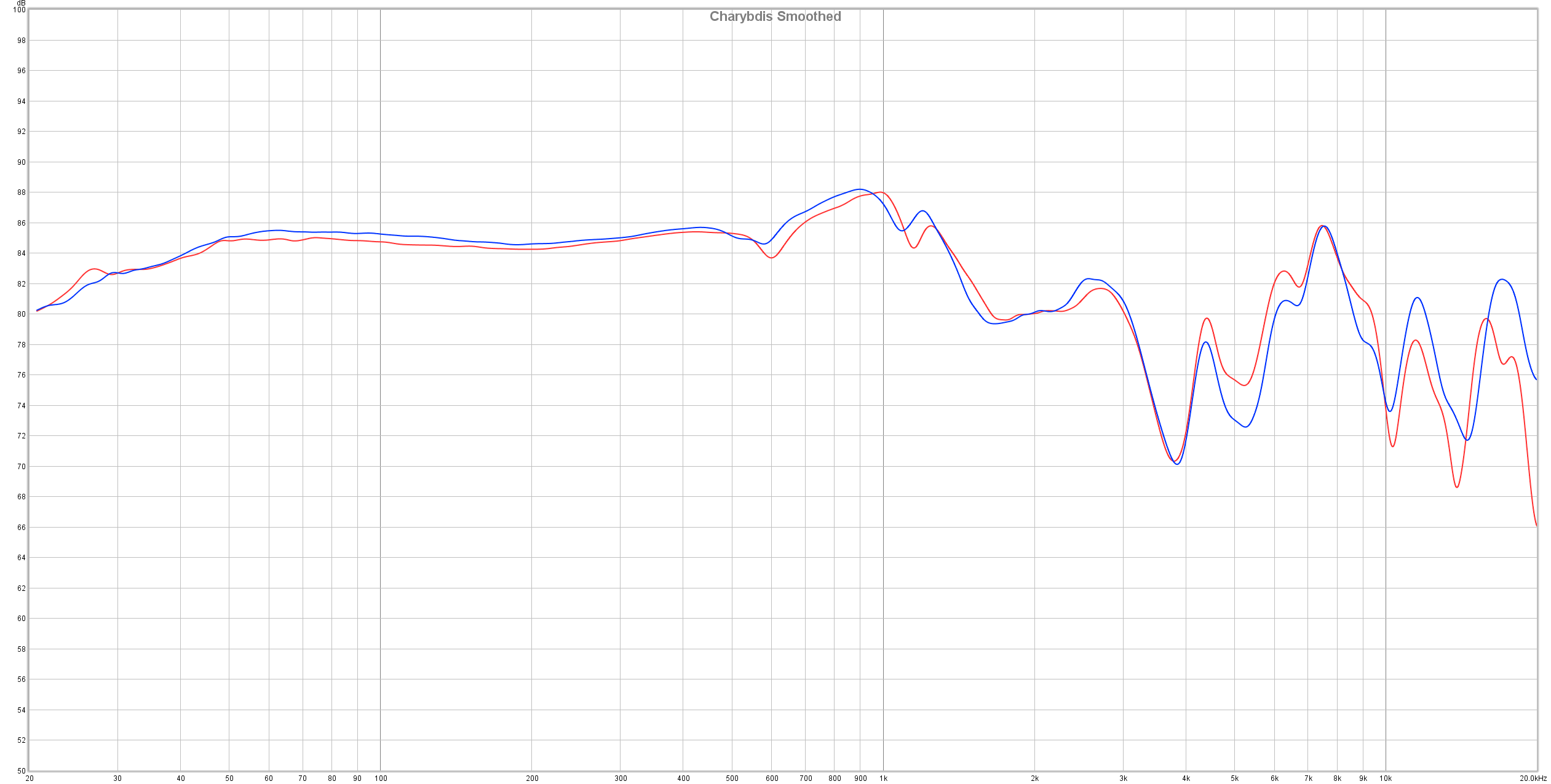
Applying a gentle 1/12 smoothing, I am getting a slightly different graph and you can see that Charybdis have a much better bass response compared to their past creations. The midrange looks fantastic and there is even a small rise between 700 Hz and 1kHz that adds some energy in there. The treble goes up and down like a roller coaster but that’s normal behavior, as all flagship headphones are doing the same. Do note that the most sensitive part of our hearing is staying on the same level with the bass and midrange, suggesting a linear frequency response and technical-sounding headphones. While there are several slopes at various locations, I can’t spot nasty rises that could badly affect their tonality.
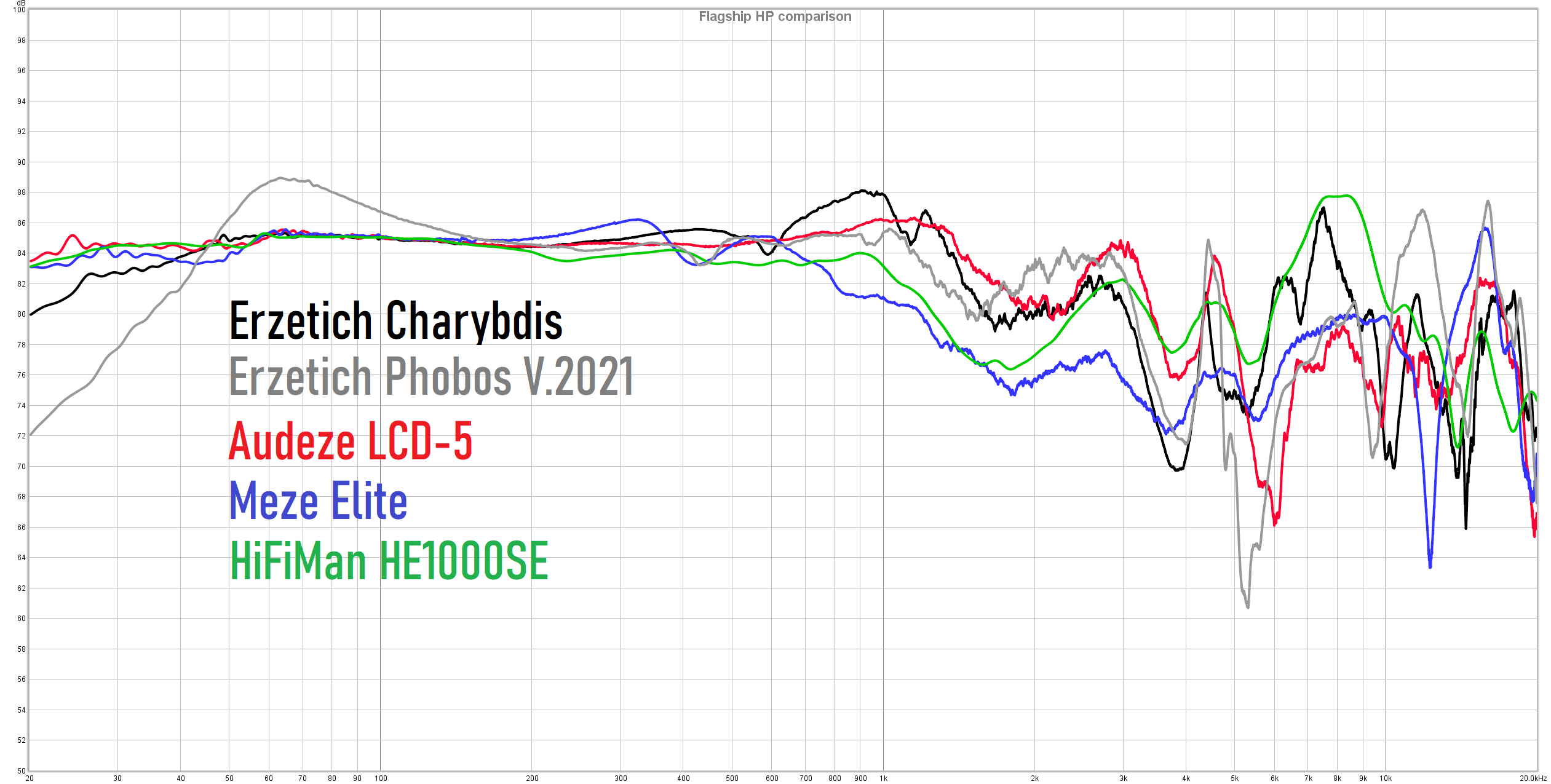
All in all, this is a good FR reading, that isn’t so different from the rest of the flagship headphones, and if you are curious how Charybdis compares to the rest of the gang, here’s a graph that will tell you more.
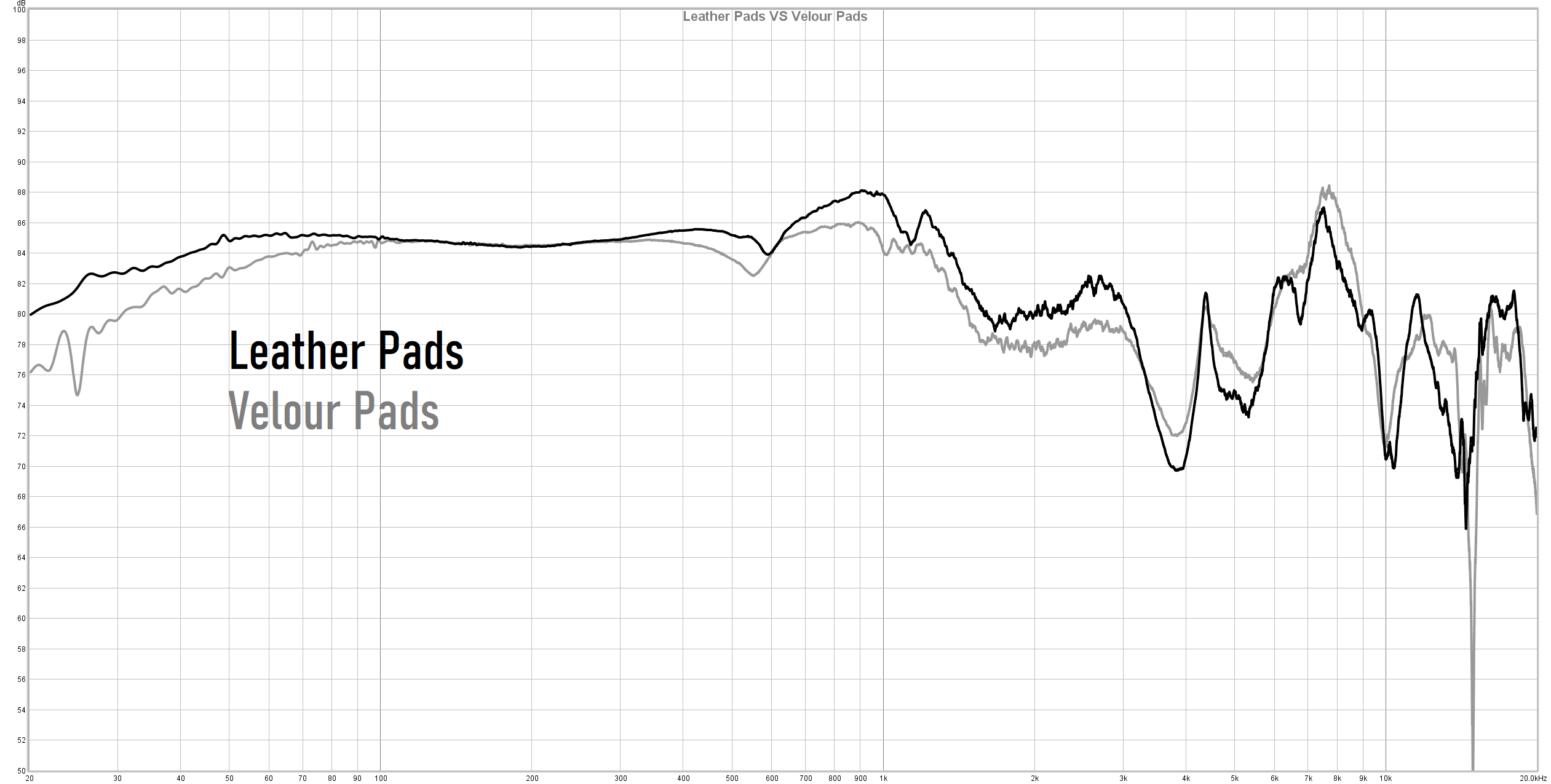
I like the sound of their stock leather pads, but if you are curious how these are stacked against velour pads that can be found in the same package, here is a graph that will tell you more. As was the case with the Meze Elite, velour earpads are adding more air, and everything feels a hair clearer and better spread around the listener, at the cost of lower dynamics and impact, especially in the bass.

Their THD reading is looking great, it can reach as high as 2% in the bass and 0.4% in the treble, but it usually stays in between 0.1 and 0.5% – which puts it in the same boat with current production flagship headphones. This is among the lowest distortion I have measured and it’s been reflected in my subjective listening impressions.

Spectral decay looks good, after sending a 300 Hz sweep tone at 84 dB, and after a short time frame of 160ms, it drops 15 dB at the lowest point and to 61 dB at the highest point in the FR, usually staying in the neighborhood of ~32 dB, which strengthens my claims that we are dealing with a fast sounding headphone, sitting on the same level with the Susvara, HE1000SE, and LCD-5.
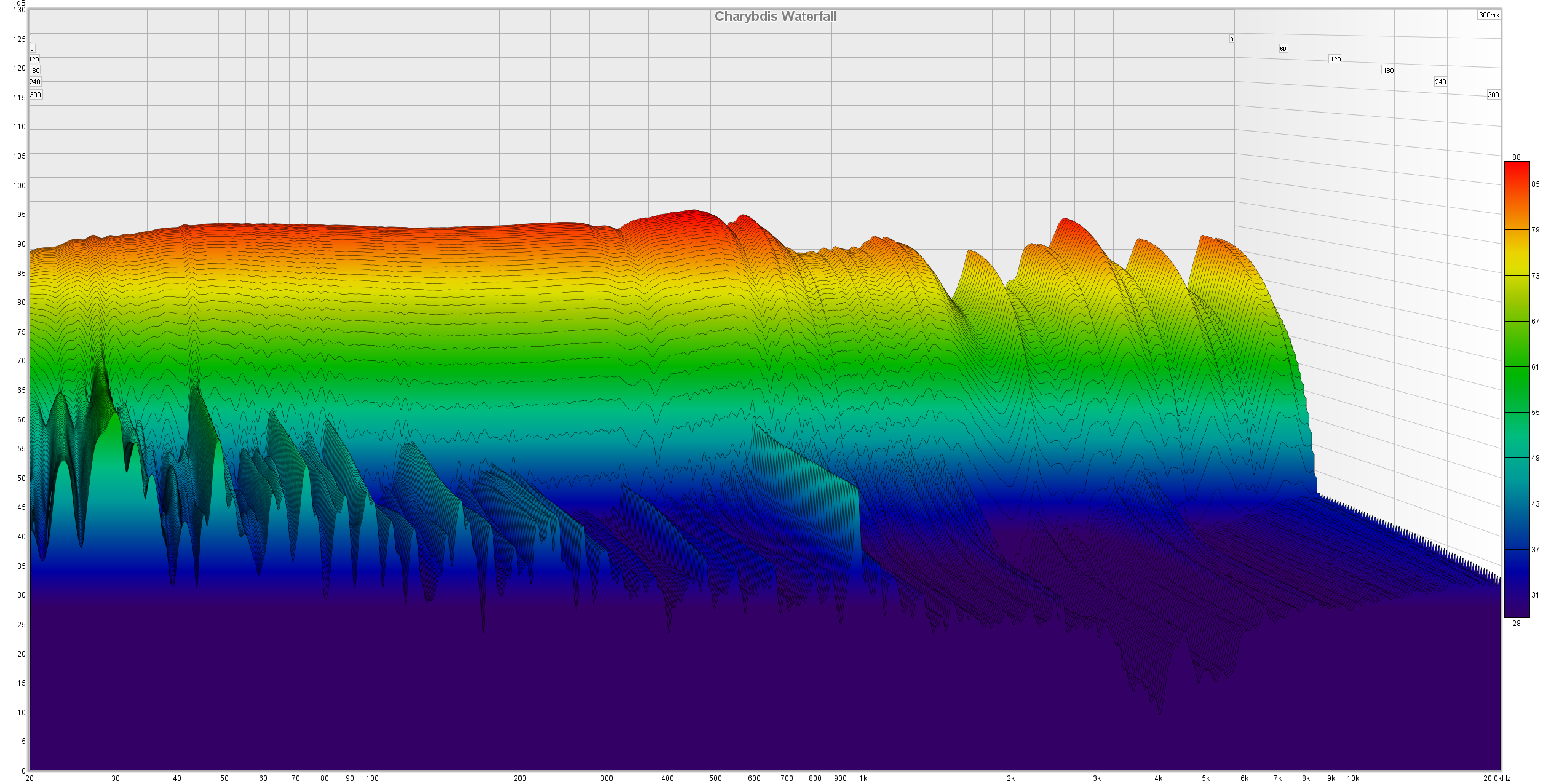
Waterfall combines the FR plot and decay into a single graph and you can better see their FR which is pretty darn close to a linearity curve, it’s impressive.
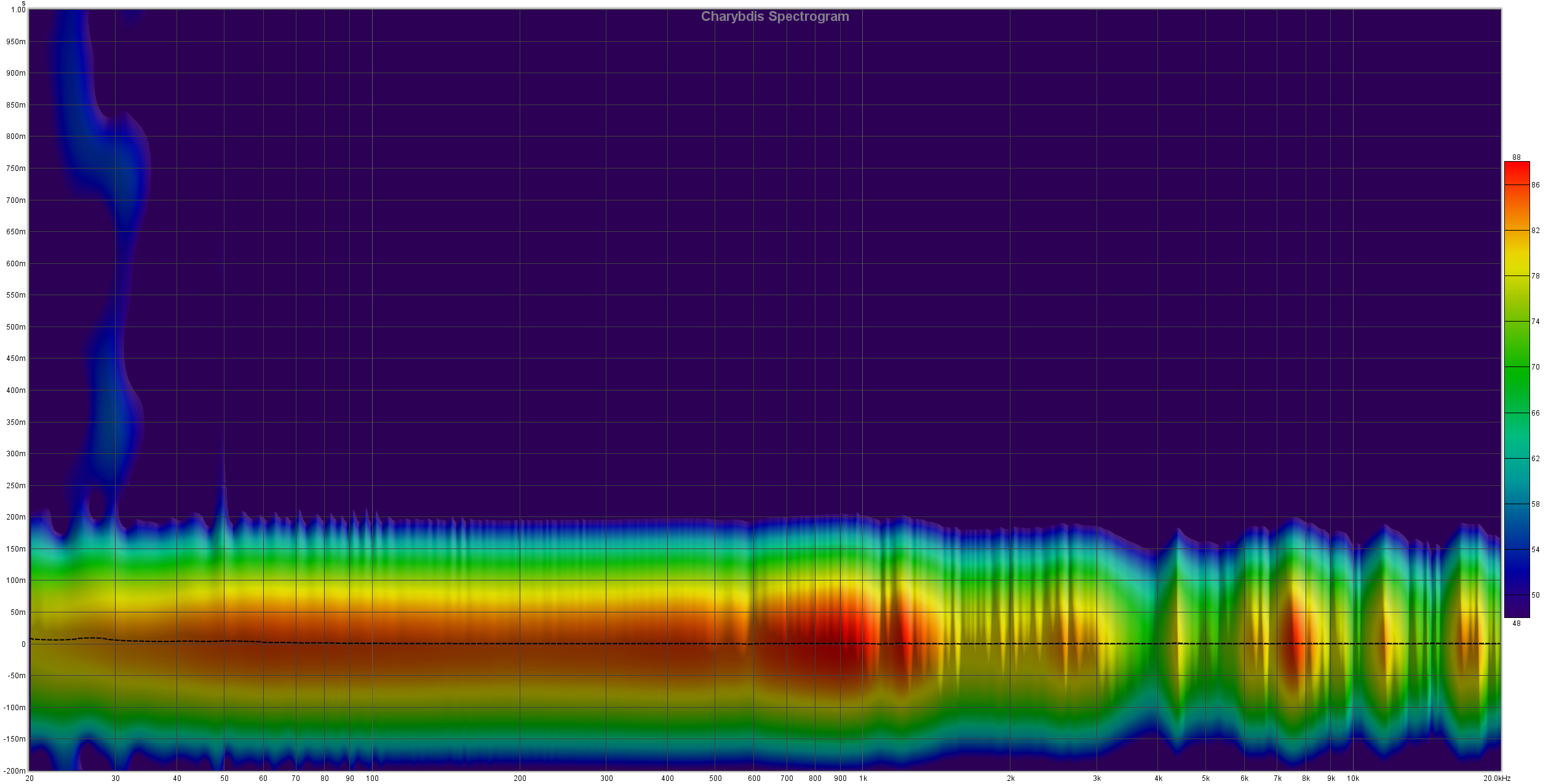
I’ve got a big surprise checking their spectrogram which usually shows a minor ringing in the bass, especially on open-back headphones, but with these, I see nothing…just a shadow of it. My listening impressions are mirroring this reading, as I couldn’t detect any cup ringing or distortion building at higher volumes.
Overall, I have recorded a much nicer frequency response (FR) to anything they’ve done before, it looks much more extended this time around, there’s a super low distortion, zero ringing of the cups in the bass, and a super-fast decay, worthy of its flagship status. When it comes to numbers, Charybdis are up there with the best I have measured.

X. Comparisons
Erzetich Charybdis (€3000) VS Erzetich Phobos V.2021 (€2000) VS Audeze LCD-4 ($4000) VS Meze Elite ($4000)
If you’re a manufacturer and my words are going to offend you in some way, then please accept my apologies, but understand that I need to stay honest with my readers and viewers. My opinions are always my own and that isn’t going to change. I’ll be as objective as possible, without taking into account my personal preference. If you’re an avid reader, please enjoy the showdown.
All my comparisons are done in the morning, after a hot shower, two poofs of Audispray, a hot coffee, and after volume matching them at 90dB with the MiniDSP EARS. All these things are mandatory, as I know that my hearing and mood levels would be at their prime.
1. When it comes to looks & build quality, I find them excellent in all regards, but I’ll give an edge to the Elite, which are much lighter, and easier to wear for prolonged sessions while having a future-fi flavor. LCD-4 don’t have an excellent weight distribution and their clamping force is still quite powerful, getting the last place, followed by Phobos and Charybdis.
- Elite: 10
- Charybdis: 9.5
- Phobos V.2021: 9
- LCD-4: 8
2. When it comes to sensitivity, Charybdis are currently the easiest to drive planars from this short list, followed by Phobos, Elite and there’s quite a gap up to LCD-4, which are considerably harder to drive, demanding bigger, beefier, and costlier amplifiers for the best results.
- Charybdis: 10
- Phobos V.2021: 9.5
- Elite: 9.5
- LCD-4: 7.5
3. When it comes to frequency response as a whole, LCD-4 offers the worst treble performance and uneven frequency response. Phobos are next, getting an unimpressive sub-bass and a slight elevation in the treble. It’s a coin toss between Elite and Charybdis, the former gently winning in the sub-bass and the latter winning the treble game, delivering more treble information across the board
- Charybdis: 9.5
- Elite: 9.5
- Phobos V.2021: 8
- LCD-4: 7.5
4. When it comes to transients as a whole, Elite, and Charybdis are leading the pack always sounding snappy, fast, and impactful, although, with the right setup, there are better dynamics with the Charybdis, getting slightly ahead of the competition. Phobos are lacking sub-bass definition and punch and LCD-4 although slamming like crazy, aren’t that fast sounding, getting the last place.
- Charybdis: 10
- Elite: 9.5
- LCD-4: 8.5
- Phobos V.2021: 8
5. Moving on to soundstage, layering, and depth, this is where Charybdis is shining like a star, always impressing the listener with the out-of-head experience. I’m always turning my head with these on reference recordings. Phobos took the second place as before Charybdis, these had an amazing soundstage. LCD-4 are deep sounding and Elite are wide sounding, but these two are more or less the same, getting the last two spots.
- Charybdis: 10
- Phobos V.2021: 9
- Elite: 8.5
- LCD-4: 8.5
6. When it comes to transparency and detail retrieval, all of them are highly resolute, with the exception of the LCD-4 which are seriously lacking behind. In my view, Charybdis are challenged only by the Hifiman Susvara and Abyss AB-1266 Phi TC in this department, always delivering a little bit more compared to the rest. Elite takes the second place, providing a good deal of information, followed by the Phobos which lacks information in the sub-bass and the most sensitive part of our hearing. LCD-4 takes the last place, lacking bite, sparkle, and resolution, especially in the highest registers.
- Charybdis: 10
- Elite: 9.5
- Phobos V.2021: 8.5
- LCD-4: 7.5
7. The most difficult part I left for last and that’s their timbre/tonality, or how natural and believable I find them. Honestly, Elite has the most believable tonality of the bunch, always sounding life-like, except for the upper treble which sometimes can get a bit hot. Charybdis is not that far off and depending on the listener, you can even like their tonality a bit more. These are neutral sounding, closer to a linearity curve, but they still have a soul when the music starts playing. LCD-4 are by far, the creamiest, sweetest sound, strongly leaning towards warmth, while discarding all traces of listening fatigue. Phobos aren’t bad in any way, but since there is less sub-bass definition and sometimes too much treble energy in the top octave, they can feel aggressive and uneven sounding, hence getting the last place.
- Elite: 10 (life-like, easy to listen to, pours naturally, can have a slight itch in the upper treble)
- Charybdis: 9.5 (more linear & honest sounding, although these are still preserving the soul of the music, the most engaging & fun sounding of the bunch)
- LCD-4: 9 (these are mixing milk and honey, overly creamy, dense, and full-bodied at the cost of some veil and smearing in the treble)
- Phobos V.2021: 8 (not that far off from Charybdis, but these are sucking out the life from the sub-bass and are planting it in the upper treble, making them uneven and sometimes aggressive in long listening sessions)
8. Final Results
- Charybdis: 68.5 points
- Elite: 66.5 points
- Phobos V.2021: 60 points
- LCD-4: 56.5 point
I didn’t take into consideration their price points and although Charybdis are more affordable than its direct competitors, they scored higher. The true battle raged between Meze Elite and Charybdis and while plenty of people would still pick the Elite and I perfectly understand that, on the technical level, Charybdis are slightly above and that made them a true bargain if you ask me.

My Conclusions
In three weeks, I put them on multiple headphone rigs, ranging from entry-level to uber-high-end desktop setups and you know what? They sounded excellent with all of them thanks to a higher-than-usual sensitivity. They don’t need 30-kilo amplifiers to work at their fullest and it should be clear by now why these are deserving your fullest attention. They have an immaculate technical performance, being challenged only by the HiFiMan Susvara from my headphone collection. They outperformed everything else I have on my headphone wall and knowing that you can have these for €3000 makes me a lot happier. I don’t support price increases, I support great sonics at affordable prices and while these are far from affordable, they feel this way when comparing them with close competitors.
I want to give back to my readers and viewers and that’s why I teamed up with Blaž Ezetič for a 15% discount (€450 OFF) for the first five customers. Please use the SOUNDNEWS promo code at checkout and a 15% discount will be automatically applied. If you lost your chance, don’t be sad as they still deserve their fullest price.
If these would cost €4000, then I would still recommend them if they would cost a little bit more, then I would recommend them only for deeper pockets, but they would still get my highest Gold Award. Brand new headphones were crafted from the ground up and instead of following the newest trends (smaller drivers), they went berserk and armed these with the biggest guns that completely unshackled the sound.

If I would nitpick a little…then that would be about their headphone connectors used as earrings and having slight microphonics with the stock cable. I used third-party cables for my evaluation and I understand why massive headphone drivers couldn’t fit a pair of connectors in the same cups.
Erzetich Charybdis were kindly provided by the man himself Blaž Erzetič and you can get them from their web-store right here. In case you’re getting a pair, please leave a comment below and let me know how these are treating you.
PROS:
- Outstanding unboxing experience, great packaging, and selection of accessories
- World-class build quality and comfort levels. Although big & heavy, I find them comfortable to wear in prolonged listening sessions
- Low impedance & highly efficient, you can drive these with pretty much anything, with the exception that upper-class equipment will squeeze the last drop of performance out of them
- Incredibly resolving and highly transparent, easily on the same level with end-game material
- I find them fast and impactful sounding, more so than their close competitors. These are doing justice to transient response junkies.
- Tightly controlled, having just the right decays depends on the material being used
- Covers the entire frequency response in full, something I could never say about previous Erzetich headphones
- The widest soundstage and the deepest depth you’ll hear on a planar headphone
- Highly technical and linear sounding
- Highly engaging sounding at all times, these will pick up the tempo immediately
- Excellent set of headphone measurements
- With the right setup, these are life-like and organic sounding
- The highest bang for the buck flagship headphone I experienced thus far
CONS:
- Slight microphonics on the stock headphone cable
- Headphone connectors sitting outside their cups
ASSOCIATED EQUIPMENT:
- DACs: Rockna Wavedream Signature XLR, Chord Electronics DAVE, SMSL D400EX, SMSL SU-10, Gustard R26, Gold Note DS-10 PLUS & PSU-10 EVO
- Wireless Streamer & Music Server: Zidoo NEO Alpha, Rockna Wavedream NET
- Roon Core: Roon Nucleus, Rockna Wavedream NET
- DDCs: Denafrips Gaia, Singxer SU-6, Matrix X-SPDIF 3
- DAPs: FiiO M17, M11S, Shanling M7, M6 Ultra, Hiby R6 III, RS2
- Headphone Amps: Trafomatic Primavera, Trafomatic Head 2, Enleum AMP-23R, Ferrum OOR + HYPSOS, Burson Soloist 3X GT, Flux Lab Acoustics Volot
- Preamps: Chord Ultima 3 Pre
- Power Amps: Chord Ultima 5, Burson Timekeeper 3X GT (x2)
- Loudspeakers: KEF Reference 3, Musician Knight 1, Sound of Eden Crescendo UNO
- IEMs: FiiO FH9, FH7S, Meze Rai Penta, LittleDot Cu KIS, 7Hz Timeless, Kinera Skuld & others
- Full-sized headphones: Erzetich Charybdis & Phobos V.2021 & Mania, HiFiMan Susvara & HE1000SE & Arya Stealth, Meze Elite & 109 PRO, Audeze LCD-5 & LCD-4, Sennheiser HD800S, Kennerton Rognir (planar) & Vali, Apos Caspian, Sendy Peacock & Apollo, HarmonicDyne Poseidon & others
- Interconnects: Crystal Cable Reference2 Diamond, QED Reference (x2), Topping TCX1 (x2)
- USB Cables: Supra USB Excalibur (x2), Chord C-USB, Matrix Hi-Fi USB
- HDMI Cables: Supra 8K HDMI 2.1 (x2)
- Speaker cables: Kimber PR8, Audioquest Type4
- Power Cables: Isotek EVO3 Premier (x3), iFi Audio SupaNova (x2)
- Balanced Isolation Power Conditioners: PLiXiR Elite BAC1500 (stereo setup), Elite BAC400 (headphone setup)


